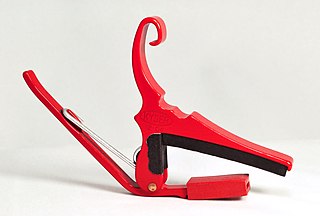
The guitar is a fretted musical instrument that typically has six strings. It is usually held flat against the player's body and played by strumming or plucking the strings with the dominant hand, while simultaneously pressing selected strings against frets with the fingers of the opposite hand. A plectrum or individual finger picks may also be used to strike the strings. The sound of the guitar is projected either acoustically, by means of a resonant chamber on the instrument, or amplified by an electronic pickup and an amplifier.

A fret is any of the thin strips of material, usually metal wire, inserted laterally at specific positions along the neck or fretboard of a stringed instrument. Frets usually extend across the full width of the neck. On some historical instruments and non-European instruments, frets are made of pieces of string tied around the neck.

A capo is a device a musician uses on the neck of a stringed instrument to transpose and shorten the playable length of the strings—hence raising the pitch. It is a common tool for players of guitars, mandolins, mandolas, banjos, ukuleles and bouzoukis. The word derives from the Italian capotasto, which means the nut of a stringed instrument. The earliest known use of capotasto is by Giovanni Battista Doni who, in his Annotazioni of 1640, uses it to describe the nut of a viola da gamba. The first patented capo was designed by James Ashborn of Wolcottville, Connecticut year 1850.
The fingerboard is an important component of most stringed instruments. It is a thin, long strip of material, usually wood, that is laminated to the front of the neck of an instrument. The strings run over the fingerboard, between the nut and bridge. To play the instrument, a musician presses strings down to the fingerboard to change the vibrating length, changing the pitch. This is called stopping the strings. Depending on the instrument and the style of music, the musician may pluck, strum or bow one or more strings with the hand that is not fretting the notes. On some instruments, notes can be sounded by the fretting hand alone, such as with hammer ons, an electric guitar technique.

Fingerstyle guitar is the technique of playing the guitar or bass guitar by plucking the strings directly with the fingertips, fingernails, or picks attached to fingers, as opposed to flatpicking. The term "fingerstyle" is something of a misnomer, since it is present in several different genres and styles of music—but mostly, because it involves a completely different technique, not just a "style" of playing, especially for the guitarist's picking/plucking hand. The term is often used synonymously with fingerpicking except in classical guitar circles, although fingerpicking can also refer to a specific tradition of folk, blues and country guitar playing in the US. The terms "fingerstyle" and "fingerpicking" are also applied to similar string instruments such as the banjo.

In music, strumming is a way of playing a stringed instrument such as a guitar, ukulele, or mandolin. A strum or stroke is a sweeping action where a finger or plectrum brushes over several strings to generate sound. On most stringed instruments, strums are typically executed by a musician's designated strum hand, while the remaining hand often supports the strum hand by altering the tones and pitches of any given strum.
Phillip J. Petillo was an American luthier. In the 1970s he built prototypes for Travis Bean and Gary Kramer for what would become Kramer Guitars.
Tacoma Guitars was an American manufacturing company of musical instruments. It was founded in 1991 as a division of South Korean company Young Chang. Instruments were manufactured in Tacoma, Washington. The company and brand name were later acquired by the Fender Musical Instruments Corporation. The Tacoma plant closed, and production ceased, in 2008.
Jean Larrivée Guitars Inc. is a Canadian company that manufactures electric and acoustic guitars. Founded in 1967 by Jean Larrivée, the company moved from Toronto, Ontario, to Victoria, British Columbia, in 1977, and to Vancouver in 1982. A second plant opened in California in September 2001. Canadian manufacturing was closed in 2013.
Harvey Reid is an American musician living in York, Maine. He won the 1981 National Fingerpicking Guitar Competition and the 1982 International Autoharp competition. In 1996, Acoustic Guitar magazine listed Harvey's album Steel Drivin' Man as one of the top 10 essential folk albums/CDs of all time. He has 19 records available from Woodpecker Records.

A partial capo is a type of a capo designed to capo only some of the strings of an instrument, as opposed to a standard capo which affects all strings.

The G-Sharp or G# guitar is an instrument in the guitar family, invented in 1997 by the Norwegian luthier Øivin Fjeld. It differs from other guitars mainly because of the short scale length of only 20.87" (530 mm), and the first four frets are actually "missing". The G-Sharp is tuned accordingly, and the standard tuning is identical to putting a capo on the 4th fret on a regular guitar: G#-D#-B-F#-C#-G#

Oluwatosin Ayoyinka OlumideAbasi, is an American musician, best known as the founder and lead guitarist of the instrumental progressive metal band Animals as Leaders. He has recorded and released five albums with Animals as Leaders: a self-titled debut, Weightless, The Joy of Motion, The Madness of Many, and their most recent album, Parrhesia.

Taylor Guitars is an American guitar manufacturer based in El Cajon, California, and is one of the largest manufacturers of acoustic guitars in the United States. They specialize in acoustic guitars and semi-hollow electric guitars. The company was founded in 1974 by Bob Taylor and Kurt Listug.

Collings Guitars is an Austin, Texas based stringed instrument manufacturer. The company was founded in 1973 by BillCollings. In addition to acoustic guitars, Collings Guitars manufactures: electric guitars, archtop guitars, mandolins and ukuleles.
Breedlove Guitars is an American acoustic instrument company based in Bend, Oregon. Breedlove produces acoustic guitars, acoustic bass guitars, and ukuleles.

Lichty Guitars is an American company based in Tryon, North Carolina, that has been making custom acoustic guitars and ukuleles since 2009. It was founded by musician Jay Lichty.
Joe Veillette, is a luthier and the owner of Veillette Guitars. He specializes in the crafting of unusual and innovative handmade guitars, basses, and other stringed instruments. Veillette's diverse client list includes John Sebastian, James Taylor, Ani DiFranco, Dave Mathews, John Mayer, Jorma Kaukonen, Steve Miller, Todd Rundgren, Chris Martin, Jimmy Vivino, Tim Pierce, Colin Hay, David Torn, Brian May, Kaki King, Neal Schon, Mike McCready, Eddie Van Halen and other notable players.

Blackbird Guitars is a musical instrument company that manufactures acoustic guitars and ukuleles from composite materials, including carbon fiber and ekoa, a flax linen reinforcement fabric in a bio-epoxy matrix. The company has made contributions to both the field of luthiery and the field of composite design, notably with the composite all-hollow unibody instrument design used on all Blackbird models, as well as the development and use of Ekoa in the construction of fretted instruments.
Weymann Guitars is an American manufacturing company of musical instruments. Established in 1864 in Philadelphia, Weymann is one of the oldest instrument companies in the country. Originally founded as "H. A. Weymann and Son" by German immigrant Henry Arnold Weymann, Weymann patented the mandolute and also developed the first "Jumbo" body acoustic guitar produced during the turn of the century, nearly two decades before competitors in the instrument industry.












